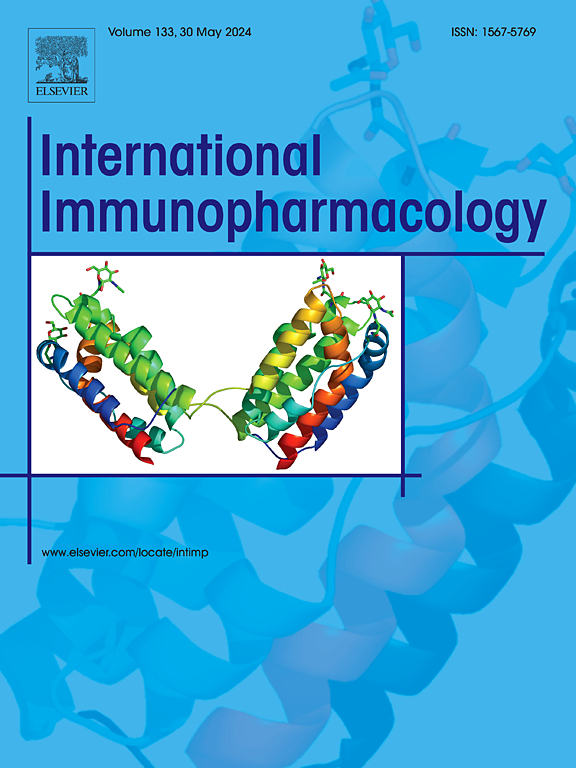Salvianolic acid A ameliorates sepsis through inhibiting inflammation via binding STING and modulating TBK1/IRF3 signaling pathway
IF 4.8
2区 医学
Q2 IMMUNOLOGY
引用次数: 0
Abstract
Sepsis is a condition characterized by a systemic inflammatory response due to infection, resulting in numerous organ dysfunction. Salvianolic acid A (SAA) is a phenolic acid substance extracted from the plant Salvia miltiorrhiza Bunge, possessing antioxidant and anti-platelet aggregation properties. Although aberrant stimulator of interferon genes (STING) signaling is associated with sepsis, it is uncertain if SAA can influence this pathway to avert sepsis-induced organ injury. This study examined the antiseptic efficacy and biological mechanisms of SAA. The pharmacodynamics and mechanism of action of SAA in countering STING-induced inflammation during sepsis were investigated utilizing a cecal ligation and puncture (CLP) sepsis animal model. In vitro, RAW264.7 and THP-1 cells were preincubated with SAA for one hour before exposure to lipopolysaccharide (LPS). The molecular mechanism of SAA in the treatment of sepsis was examined by biochemical assays, pathological sections, enzyme-linked immunosorbent assay (ELISA), and western blot analysis. The association between SAA and its targets was examined via cellular thermal shift assay (CETSA), molecular docking, and molecular dynamics simulation analysis. The SAA intervention enhanced the survival rate of mice (18.75 % in the model group versus 55 % in the high-dose group) and dramatically reduced neutrophil infiltration in lung tissue as well as histological changes. It enhanced hepatorenal function and reduced inflammatory cytokines. Furthermore, the in vivo findings demonstrated that SAA could suppress the activation of the STING and TBK1/IRF3 signaling pathway, corroborating the in vitro results. SAA directly interacts with STING and regulates the TBK1/IRF3 signaling pathway to mitigate organ damage and inflammation caused by sepsis. It may serve as a viable therapeutic agent and prospective STING inhibitor.
脓毒症是一种以感染引起全身炎症反应为特征的疾病,导致许多器官功能障碍。丹酚酸A (Salvianolic acid A, SAA)是从植物丹参中提取的酚酸类物质,具有抗氧化和抗血小板聚集的特性。尽管干扰素基因刺激因子(STING)信号异常与脓毒症有关,但尚不确定SAA是否可以影响该途径以避免脓毒症诱导的器官损伤。本研究探讨了SAA的防腐效果和生物学机制。利用盲肠结扎和穿刺(CLP)脓毒症动物模型,研究SAA在脓毒症期间对抗sting诱导炎症的药效学和作用机制。在体外,RAW264.7和THP-1细胞与SAA预孵育1小时,然后暴露于脂多糖(LPS)。通过生化试验、病理切片、酶联免疫吸附试验(ELISA)和western blot分析,探讨SAA治疗脓毒症的分子机制。通过细胞热移分析(CETSA)、分子对接和分子动力学模拟分析来研究SAA与其靶点之间的关联。SAA干预提高了小鼠的存活率(模型组为18.75%,高剂量组为55%),并显著减少肺组织中性粒细胞浸润和组织学改变。增强肝肾功能,降低炎症因子。此外,体内研究结果表明,SAA可以抑制STING和TBK1/IRF3信号通路的激活,与体外研究结果一致。SAA直接与STING相互作用,调节TBK1/IRF3信号通路,减轻败血症引起的器官损伤和炎症。它可能是一种可行的治疗药物和有前景的STING抑制剂。
本文章由计算机程序翻译,如有差异,请以英文原文为准。
求助全文
约1分钟内获得全文
求助全文
来源期刊
CiteScore
8.40
自引率
3.60%
发文量
935
审稿时长
53 days
期刊介绍:
International Immunopharmacology is the primary vehicle for the publication of original research papers pertinent to the overlapping areas of immunology, pharmacology, cytokine biology, immunotherapy, immunopathology and immunotoxicology. Review articles that encompass these subjects are also welcome.
The subject material appropriate for submission includes:
• Clinical studies employing immunotherapy of any type including the use of: bacterial and chemical agents; thymic hormones, interferon, lymphokines, etc., in transplantation and diseases such as cancer, immunodeficiency, chronic infection and allergic, inflammatory or autoimmune disorders.
• Studies on the mechanisms of action of these agents for specific parameters of immune competence as well as the overall clinical state.
• Pre-clinical animal studies and in vitro studies on mechanisms of action with immunopotentiators, immunomodulators, immunoadjuvants and other pharmacological agents active on cells participating in immune or allergic responses.
• Pharmacological compounds, microbial products and toxicological agents that affect the lymphoid system, and their mechanisms of action.
• Agents that activate genes or modify transcription and translation within the immune response.
• Substances activated, generated, or released through immunologic or related pathways that are pharmacologically active.
• Production, function and regulation of cytokines and their receptors.
• Classical pharmacological studies on the effects of chemokines and bioactive factors released during immunological reactions.

 求助内容:
求助内容: 应助结果提醒方式:
应助结果提醒方式:


